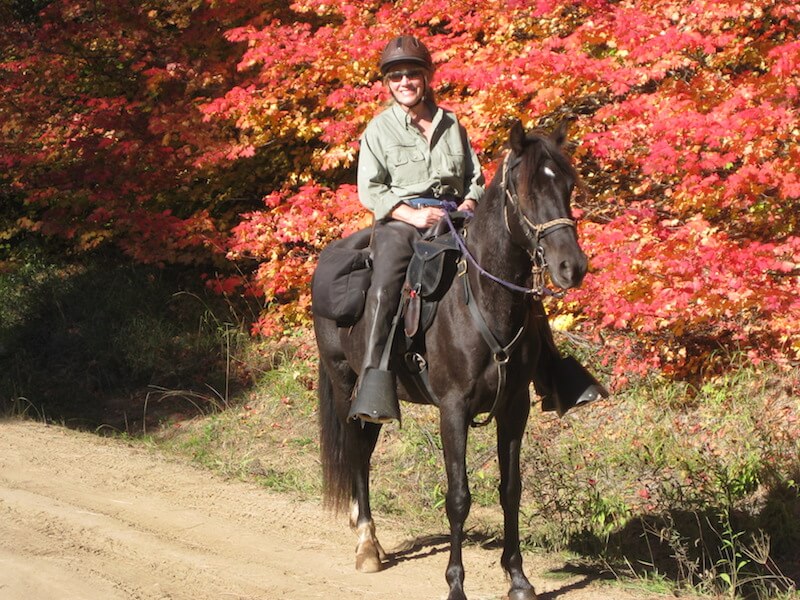Four Things to Consider Before Purchasing Your Next Ride
by Robert Eversole
It’s a brand new year and maybe a fresh start on the trail with a new companion. I’m often asked what kind of horse makes a good trail horse and my usual answer is “one with four legs.” While technically correct, this response certainly leaves more questions to answer.
Anyone who enjoys trail riding will tell you that a good trail horse or mule is worth his weight in gold and is just as much an athlete as any other performance horse. Anytime I look for a new trail mount to accompany me into the backcountry, I look for a combination of personality and conformational traits. Recently I visited Stride Right Farms and spoke to Mel and Deb Kulhman to find out what traits they aim for in their Rocky Mountain trail horse breeding program.

Personality
We agreed that a horse, or mule, with a kind and willing disposition is much easier to work with and train for the myriad of challenges that it will be asked to face. Unless you like drama on your rides, look for a horse that is not over-reactive or possesses an overly high flight instinct. A calm yet willing disposition will help a good trail horse, one that can stand quietly while tied, remain calm on the edge of a mountain, and get along with other horses in camp (as well as cows, dogs, elk, and deer).
Age and Experience
Age is always a factor and younger is not necessarily better. With a seasoned horse you can get on and go from day one. A healthy 10- or 12-year old horse still has many good years left in him and you can enjoy the trails right away. Likewise, a mount with real trail experience can often be worth a higher purchase price, especially if you are just starting out or if you want a better chance of avoiding problems on the trail. A rodeo 10 miles from the trailer is no fun.
Conformation
In trail riding, beauty is as beauty does and a good horse is never the wrong color. Conformation traits rewarded in the show ring for their aesthetic value mean nothing if they don’t help the horse get down the trail. I’ve seen horses and mules of all shapes and sizes succeed as good, competent trail mounts. Most of them prove the rule that “form is function.” Structurally correct horses are more likely to stay sound over the many miles of repetitive motion and concussion that trail riding entails. Also, your mount should be big enough to do the job and as short as possible. A tall horse is impressive but the back country is woefully lacking in ready-made mounting blocks. Soundness is often related to conformation and is an important consideration. If the horse has a history of lameness or unsoundness he may not be sturdy enough to cover long miles of varied and rough terrain and you will only cause him pain and yourself heartache. Making your way into the backcountry is hard work and access to those stunning vistas is earned, not given.
Try Him Out!
Once you find a horse that has the qualities you desire and that you think would make a great trail buddy, try him out to see how he is in a few different situations. Mel and Deb at Stride Right Farms encourage people to take their time before buying to make sure they’ve found the right partner. Take the prospect out on a few trail rides and get to know the horse or mule in the environment you are going to be using him in to see if he enjoys the trails as much as you do. Hopefully, this will tell you just what level of experience he truly has and whether all those traits you saw at the barn are still there on the trail, where you really need them.
 Wishing you a trail-filled New Year! As always, for the largest directory of horse trails and camping areas in the U.S. to visit with your new horse or mule, visit www.TrailMeister.com
Wishing you a trail-filled New Year! As always, for the largest directory of horse trails and camping areas in the U.S. to visit with your new horse or mule, visit www.TrailMeister.com
Published January 2013 Issue

Robert Eversole, ”the trail meister,” owns www.TrailMeister.com, the largest database of horse riding and camping areas in the U.S. with free trail and trailhead information, trail maps, and much more to help horse enthusiasts experience the joys of trail riding. Robert is a registered riding instructor with PATH International, a mounted search and rescue team member, and a U.S. Marine who has served on the board of the Backcountry Horsemen of Washington (BCHW). He is enjoying his new career helping fellow trail riders stay found and safe on the trail. When not on the trail, The Trail Meister resides near Spokane, WA and teaches land navigation to a wide variety of outdoor groups across the nation. For North America’s largest horse trail and camping directory, trail tips, and more, visit www.TrailMeister.com.

